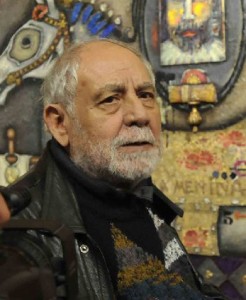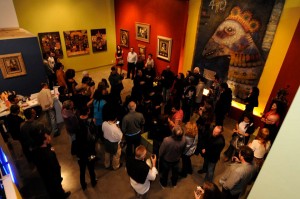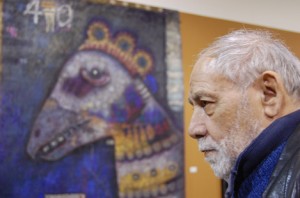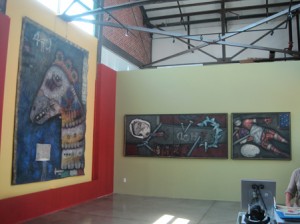Even when I have a good concept and all my ducks are in a row, I always feel somewhat at a loss when facing a blank canvas for the first time. So when I learned that the renowned Mexican artist Munoz Acosta (whose mini-retrospective “My Brother’s Flight / El Vuelo de mi Hermano” is currently at ADC Contemporary Gallery) envisioned a blank canvas as a container in which to put his menagerie of objects, I wondered why I never thought of something so simple and elegant to calm my angst.
Acosta’s exhibit is formidable: earthy, naive honesty combined with the sophistication of a thoroughly trained and reconciled artist (he studied at the National Art Academy in Mexico City and in Paris during the ‘70’s). The show has representative works from 1977 to his fresh paintings done last year. It illuminates an artist who makes a singular point to explore his psychological life in visual language comfortable to him.
Hung by Marisa Caichiolo, the gallery’s vivacious director, the works of Acosta really sing. Caichiolo actually creates a work of art within the exhibit by painting the many walls shades of all the primary colors, adding the secondary color green to the mix. While most galleries play it safe with the color white, Caichiolo, an artist herself, feels totally comfortable daring the presentation envelope. I’m proud to have some of my last year’s work included on their web site.
So what are the objects that Acosta tosses into his container? Lots of shoes, Mexican flags, eggs sunny side up, birds, fish, monkeys, hearts, horses, family photos, religious items, clothing, musical instruments and more. The ubiquitous lemon is probably the most recurring symbol. These objects have a personal history. For example, the lemon goes back to his early childhood when he lived in the Sonora desert and all the children had to bring a lemon to school each day to prevent dehydration.
Acosta’s psychological journey of discovery is not self-absorbed; his objects present his collection from past memories–his visual record–and his visual journey through life. As bold and conspicuous as Acosta’s paintings are, they speak more to his inner, even secretive world. His objects are less about coming out of the canvas towards the viewer and more about pulling the gaze inwardly into his personal iconography.
Using wood, fabric, oil, acrylic, photographs, and found objects, Acosta creates his collages. He works the entire canvas over and over again, ever deepening the volume and textures at each successive pass. Some of the works are done on an easel, others on the floor. Connie Ellig, a woman who writes about life in Ensenada (the artist’s favored location, as important to him as Abiquiu was to Georgia O’Keeffe), notes that he is “…a master of assemblage and an artist who tears apart reality and puts it back together.” Acosta himself feels that he does more constructing than painting, blending both elements much as a Robert Rauschenberg or a Larry Rivers might. A given painting is important only while he works on it; once the work is finished, he dissolves any attachment to it.
The first thing one sees when entering the gallery is his large 140“by 96” (1999) painting of a mythological-looking animal wearing a crown. It’s a very gutsy piece, especially when you realize that he painted it (with fabric collages) on the back of a rug. The coarse texture of the rug imparts a uniform scintillating feel to the oils on its surface.
Nearby is a large 1998 triptych entitled “Shostakovich,” which hints heavily of Mexican mural traditions, especially those of Siqueiros; Acosta’s roots reach deep into European and Mexican traditions. A large number of Acosta’s works are homage to other creative souls such as Paganini, Puccini, Wagner, Lorca, Proust, Goya, Magritte, and many others; all testimony of a well-read artist.
Also on exhibit are a number of his early drawings from the 1970’s, often looking like hybrids between a Rico Le Brun and a Phillip Guston. The exhibit includes a beautifully illustrated retrospective book and a DVD (neither translated into English).
In 2004 Acosta’s older brother– his lifelong critic and manager of his artwork–died, leaving him totally devastated. In spite of profound depression he continued to paint, designating all his art under the title of “My Brother’s Flight.” And yet his current work continues the same tradition of his earlier ones, full of life and optimism.
Much revered in Mexico and little known in the States, Acosta’s first exhibition ironically was in Los Angeles. The paintings of Munoz Acosta, when all is said and done, are a testament to a profound journey by an extremely sensitive artist and man, an example to all artists of what devoting one’s life to art can be.








This is a great blog and love the photo’s with the story… Keep up the good work.
I like the work and again, your write-up. Thanks for doing this and sending it on, I am looking forward to your e-mails.
Renata
Rene you are an amazing artist! and writer! You did justice to the work of the Master. Congratulations on a job well done!!
Marisa